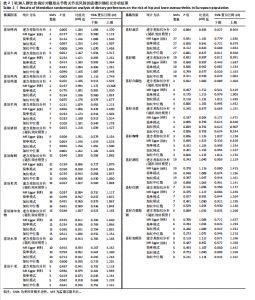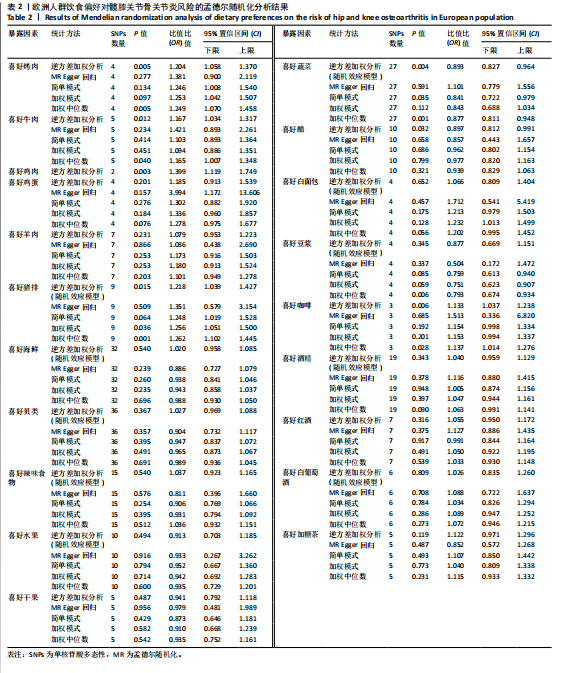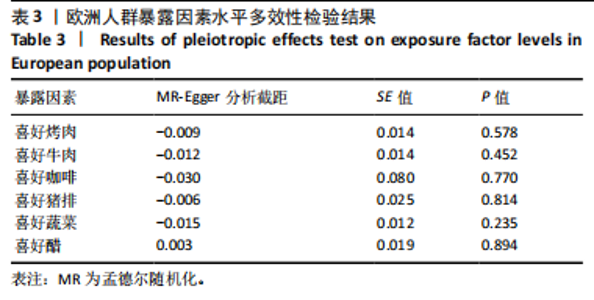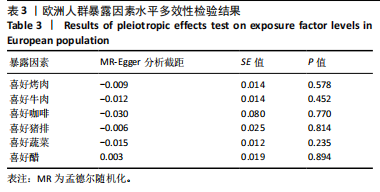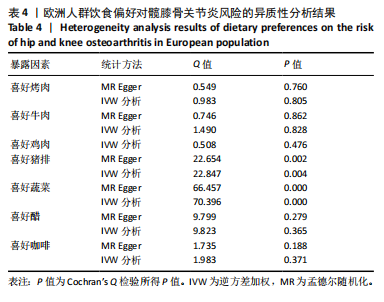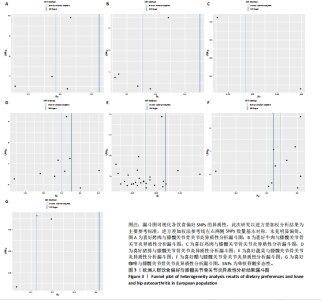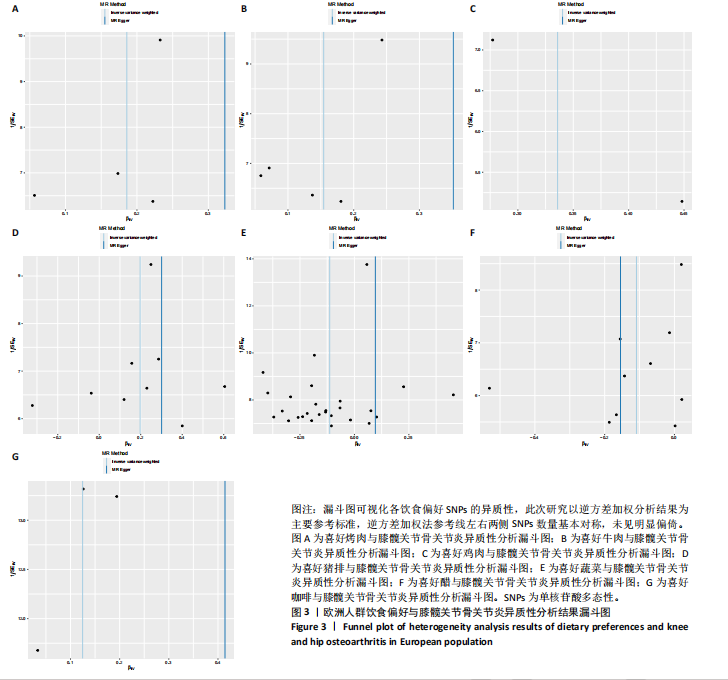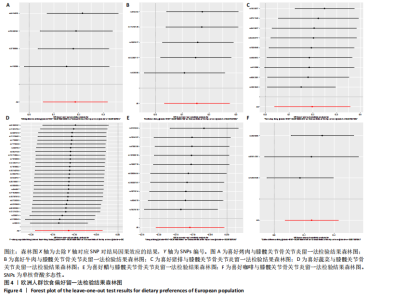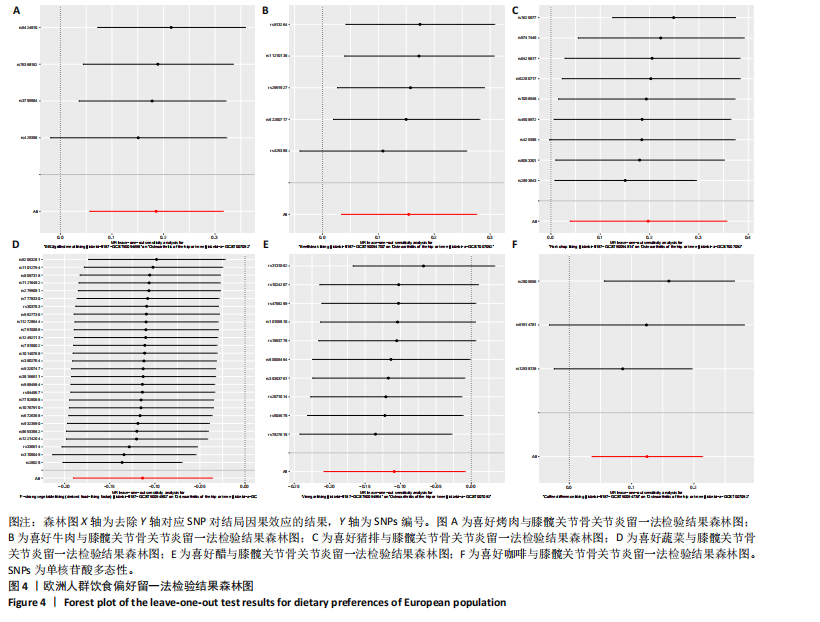Chinese Journal of Tissue Engineering Research ›› 2025, Vol. 29 ›› Issue (29): 6333-6342.doi: 10.12307/2025.790
Previous Articles Next Articles
Association between dietary preferences and the risk of osteoarthritis in Europeans: analysis of human genome-wide association study data
Pang Jiahui1, Wang Bo1, 2, Hu Yingxuan1, Hu Ziwei1, Wu Wen1
- 1Department of Rehabilitation, Zhujiang Hospital, Southern Medical University, Guangzhou 510282, Guangdong Province, China; 2Department of Rehabilitation, Wuhan No. 1 Hospital, Wuhan 430000, Hubei Province, China
-
Received:2024-08-06Accepted:2024-10-18Online:2025-10-18Published:2025-03-10 -
Contact:Wu Wen, Professor, Chief physician, Doctoral supervisor, Department of Rehabilitation, Zhujiang Hospital, Southern Medical University, Guangzhou 510282, Guangdong Province, China -
About author:Pang Jiahui, Master candidate, Department of Rehabilitation, Zhujiang Hospital, Southern Medical University, Guangzhou 510282, Guangdong Province, China -
Supported by:National Natural Science Foundation of China, No. 82172526, No. 82372553 (to WW); Guangdong Basic and Applied Basic Research Foundation, No. 2023A1515010200 (to WW)
CLC Number:
Cite this article
Pang Jiahui, Wang Bo, Hu Yingxuan, Hu Ziwei, Wu Wen. Association between dietary preferences and the risk of osteoarthritis in Europeans: analysis of human genome-wide association study data[J]. Chinese Journal of Tissue Engineering Research, 2025, 29(29): 6333-6342.
share this article
Add to citation manager EndNote|Reference Manager|ProCite|BibTeX|RefWorks
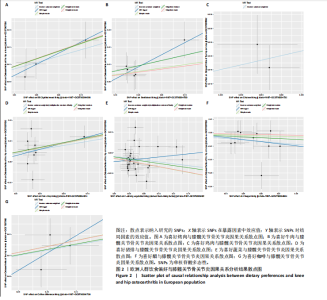
2.1 工具变量筛选结果 在20种饮食偏好遗传统计数据集中以P < 5×10-8、F > 10为过滤条件获取与暴露因素强相关的SNPs。为保证SNPs作为工具变量的独立性,以连锁不平衡参数r2=0.001,遗传距离10 000 kb进一步对SNPs进行筛选。从IEU官网获得结局遗传信息数据集后,筛选其中与暴露因素强相关的SNPs,删除回文SNPs及与混杂因素相关的SNPs后,共209个SNPs用于饮食偏好与髋膝关节骨关节炎间的因果关系分析,所有SNPs均满足相关性假设、独立性假设及排他性假设要求。 2.2 饮食偏好与髋膝关节骨关节炎的因果效应分析 饮食偏好与髋膝关节骨关节炎的因果效应孟德尔随机化分析结果见表2。逆方差加权分析方法结果显示,在饮食偏好中,喜好鸡蛋、羊肉、海鲜、贝类、辣味食物、水果、干果、白面包、豆浆、酒精、红酒、白葡萄酒及加糖茶与膝髋关节骨关节炎间无显著因果效应(P > 0.05)。此外,此次研究发现共7种饮食偏好与膝髋关节骨关节炎间存在因果关系。其中,喜好烤肉(OR=1.204, 95%CI:1.058-1.370,P=0.005)、牛肉(OR=1.167,95%CI:1.034-1.317,P=0.012)、鸡肉(OR=1.399,95%CI:1.119-1.749,P=0.003)、猪排(OR=1.218,95%CI:1.039-1.427,P=0.015)及咖啡(OR=1.133,95%CI:1.037-1.238,P=0.006)是膝髋关节骨关节炎的风险因素;喜好蔬菜(OR=0.893,95%CI:0.827-0.964,P=0.004)和醋(OR=0.897,95%CI:0.812-0.991,P=0.032)与膝髋关节骨关节炎间具有负向因果关系。7种饮食偏好对膝髋关节骨关节炎因果效应散点图如图2所示。"
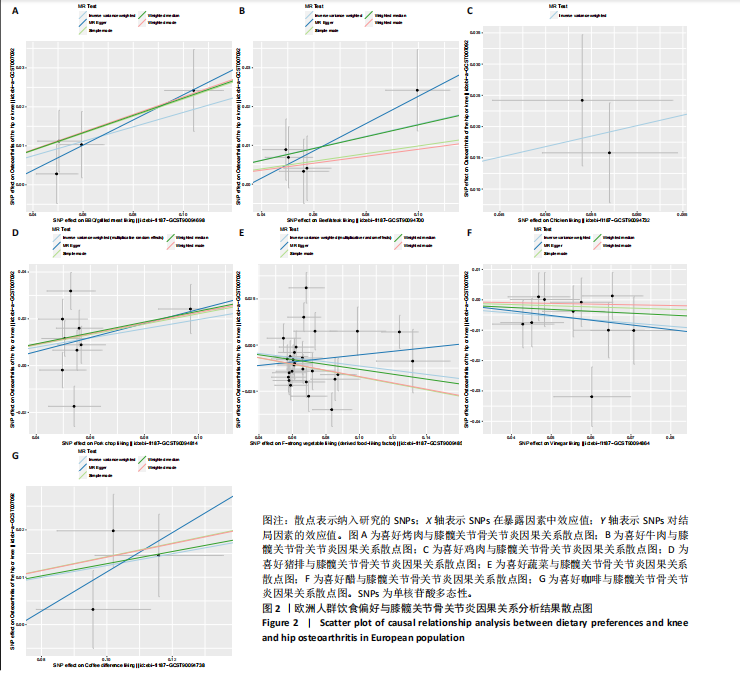
| [1] ZHONG G, MADRY H, CUCCHIARINI M. Mitochondrial Genome Editing to Treat Human Osteoarthritis-A Narrative Review. Int J Mol Sci. 2022; 23(3):1467. [2] WOOD MJ, MILLER RE, MALFAIT AM. The Genesis of Pain in Osteoarthritis: Inflammation as a Mediator of Osteoarthritis Pain. Clin Geriatr Med. 2022;38(2):221-238. [3] HUNTER DJ, MARCH L, CHEW M. Osteoarthritis in 2020 and beyond: a Lancet Commission. Lancet. 2020;396(10264):1711-1712. [4] RATHBUN AM, STUART EA, SHARDELL M, et al. Dynamic Effects of Depressive Symptoms on Osteoarthritis Knee Pain. Arthritis Care Res (Hoboken). 2018;70(1):80-88. [5] HUNTER DJ. Osteoarthritis Management: Time to Change the Deck. J Orthop Sports Phys Ther. 2017;47(6):370-372. [6] WANG H, LIAO R, TANG W, et al. Dietary inflammation index and osteoarthritis in the elderly: is there a mediating role of physical activity? Br J Nutr. 2022;128(11):2258-2266. [7] WEI Y, ZHANG T, LIU Y, et al. Ultra-processed food consumption, genetic susceptibility, and the risk of hip/knee osteoarthritis. Clin Nutr. 2024; 43(6):1363-1371. [8] LIU T, XU C, DRIBAN JB, et al. Whole grain consumption and risk of radiographic knee osteoarthritis: a prospective study from the Osteoarthritis Initiative. Rheumatology (Oxford). 2023;62(5):1834-1840. [9] ZENG J, FRANKLIN DK, DAS A, et al. The effects of dietary patterns and food groups on symptomatic osteoarthritis: A systematic review. Nutr Diet. 2023;80(1):21-43. [10] SEKULA P, DEL GRECO MF, PATTARO C, et al. Mendelian Randomization as an Approach to Assess Causality Using Observational Data. J Am Soc Nephrol. 2016;27(11):3253-3265. [11] MAY-WILSON S, MATOBA N, WADE KH, et al. Large-scale GWAS of food liking reveals genetic determinants and genetic correlations with distinct neurophysiological traits. Nat Commun. 2022;13(1):2743. [12] MOUNIER N, KUTALIK Z. Bias correction for inverse variance weighting Mendelian randomization. Genet Epidemiol. 2023;47(4):314-331. [13] KANTERS S. Fixed- and Random-Effects Models. Methods Mol Biol. 2022;2345:41-65. [14] WANG Y, SIMPSON JA, WLUKA AE, et al. Meat consumption and risk of primary hip and knee joint replacement due to osteoarthritis: a prospective cohort study. BMC Musculoskelet Disord. 2011;12:17. [15] ZHU D, WANG X, XI Z, et al. Diet influences knee osteoarthritis osteophyte formation via gut microbiota and serum metabolites. iScience. 2024;27(6):110111. [16] ÇOLAK B, KÜRKLÜ NS, ADIGÜZEL KT, et al. Dietary and serum antioxidant capacity is inversely associated with patients in osteoarthritis: a case-control study. J Health Popul Nutr. 2024;43(1):101. [17] XU C, LIU T, DRIBAN JB, et al. Dietary patterns and risk of developing knee osteoarthritis: data from the osteoarthritis initiative. Osteoarthritis Cartilage. 2021;29(6):834-840. [18] GRIFFIN TM, FERMOR B, HUEBNER JL, et al. Diet-induced obesity differentially regulates behavioral, biomechanical, and molecular risk factors for osteoarthritis in mice. Arthritis Res Ther. 2010;12(4):R130. [19] WAUQUIER F, LEOTOING L, COXAM V, et al. Oxidative stress in bone remodelling and disease. Trends Mol Med. 2009;15(10):468-477. [20] SAMRAJ AN, PEARCE OM, LÄUBLI H, et al. A red meat-derived glycan promotes inflammation and cancer progression. Proc Natl Acad Sci U S A. 2015;112(2):542-547. [21] SHI W, HUANG X, SCHOOLING CM, et al. Red meat consumption, cardiovascular diseases, and diabetes: a systematic review and meta-analysis. Eur Heart J. 2023;44(28):2626-2635. [22] JOHNSON CSC, SHIVELY CA, MICHALSON KT, et al. Contrasting effects of Western vs Mediterranean diets on monocyte inflammatory gene expression and social behavior in a primate model. Elife. 2021; 10:e68293. [23] ZHANG Y, JI Q. Macrophage polarization in osteoarthritis progression: a promising therapeutic target. Front Cell Dev Biol. 2023;11:1269724. [24] ZHANG H, LIN C, ZENG C, et al. Synovial macrophage M1 polarisation exacerbates experimental osteoarthritis partially through R-spondin-2. Ann Rheum Dis. 2018;77(10):1524-1534. [25] LIU B, ZHANG M, ZHAO J, et al. Imbalance of M1/M2 macrophages is linked to severity level of knee osteoarthritis. Exp Ther Med. 2018; 16(6):5009-5014. [26] ZHANG H, CAI D, BAI X. Macrophages regulate the progression of osteoarthritis. Osteoarthritis Cartilage. 2020;28(5):555-561. [27] BANG CH, KIM C, KIM JH, et al. Is knee osteoarthritis related to coffee drinking? A nationwide cross-sectional observational study. Clin Rheumatol. 2019;38(3):817-825. [28] CHOI H, CHOI Y, KIM J, et al. Longitudinal bone growth is impaired by direct involvement of caffeine with chondrocyte differentiation in the growth plate. J Anat. 2017;230(1):117-127. [29] DRANOFF JA. Coffee, adenosine, and the liver. Purinergic Signal. 2024; 20(1):21-28. [30] CORCIULO C, LENDHEY M, WILDER T, et al. Endogenous adenosine maintains cartilage homeostasis and exogenous adenosine inhibits osteoarthritis progression. Nat Commun. 2017;8:15019. [31] CORCIULO C, CASTRO CM, COUGHLIN T, et al. Intraarticular injection of liposomal adenosine reduces cartilage damage in established murine and rat models of osteoarthritis. Sci Rep. 2020;10(1):13477. [32] ANSARI MY, AHMAD N, HAQQI TM. Oxidative stress and inflammation in osteoarthritis pathogenesis: Role of polyphenols. Biomed Pharmacother. 2020;129:110452. [33] LEE SA, MOON SM, HAN SH, et al. Chondroprotective effects of aqueous extract of Anthriscus sylvestris leaves on osteoarthritis in vitro and in vivo through MAPKs and NF-κB signaling inhibition. Biomed Pharmacother. 2018;103:1202-1211. [34] AHMAD N, ANSARI MY, BANO S, et al. Imperatorin suppresses IL-1β-induced iNOS expression via inhibiting ERK-MAPK/AP1 signaling in primary human OA chondrocytes. Int Immunopharmacol. 2020;85: 106612. [35] MARTINS BC, SOARES AC, MARTINS FF, et al. Coffee consumption prevents obesity-related comorbidities and attenuates brown adipose tissue whitening in high-fat diet-fed mice. J Nutr Biochem. 2023;117: 109336. [36] ZHANG X, XU J. The effect of coffee consumption on three main bone disorders: a Mendelian randomization trial. J Bone Miner Metab. 2024;42(6):633-646. [37] LEE YH. Investigating the possible causal association of coffee consumption with osteoarthritis risk using a Mendelian randomization analysis. Clin Rheumatol. 2018;37(11):3133-3139. [38] ZHENG S, WU F, WINZENBERG T, et al. The cross-sectional and longitudinal associations of dietary patterns with knee symptoms and MRI detected structure in patients with knee osteoarthritis. Osteoarthritis Cartilage. 2021;29(4):527-535. [39] RUAN G, YANG C, MENG T, et al. Associations between diet quality and knee joint structures, symptoms and systemic abnormalities in people with symptomatic knee osteoarthritis. Clin Nutr, 2021;40(5):2483-2490. [40] CHEN M, HUANG L, LV Y, et al. Sulforaphane protects against oxidative stress‑induced apoptosis via activating SIRT1 in mouse osteoarthritis. Mol Med Rep. 2021;24(2):612. [41] RUAN H, ZHU T, WANG T, et al. Quercetin Modulates Ferroptosis via the SIRT1/Nrf-2/HO-1 Pathway and Attenuates Cartilage Destruction in an Osteoarthritis Rat Model. Int J Mol Sci. 2024;25(13):7461. [42] SINGH K, GUPTA JK, KUMAR S. The Pharmacological Potential of Resveratrol in Reducing Soft Tissue Damage in Osteoarthritis Patients. Curr Rheumatol Rev. 2024;20(1):27-38. [43] BUDAK NH, AYKIN E, SEYDIM AC, et al. Functional properties of vinegar. J Food Sci. 2014;79(5):R757-R764. [44] LI Y, JIA X, TANG N, et al. Melanoidins, extracted from Chinese traditional vinegar powder, inhibit alcohol-induced inflammation and oxidative stress in macrophages via activation of SIRT1 and SIRT3. Food Funct. 2021;12(17):8120-8129. [45] XIA T, DUAN W, ZHANG Z, et al. Polyphenol-rich vinegar extract regulates intestinal microbiota and immunity and prevents alcohol-induced inflammation in mice. Food Res Int. 2021;140:110064. [46] XIE Z, QIN Y. Is diet related to osteoarthritis? A univariable and multivariable Mendelian randomization study that investigates 45 dietary habits and osteoarthritis. Front Nutr. 2023;10:1278079. [47] LIANG R, ZHONG W, ZE S, et al. Causal association between dried fruit intake and risk of osteoarthritis: A Mendelian randomization study. Medicine (Baltimore). 2024;103(14):e37710. |
| [1] | Zhang Yibo, Lu Jianqi, Mao Meiling, Pang Yan, Dong Li, Yang Shangbing, Xiao Xiang. Exploring the causal relationship between rheumatoid arthritis and coronary atherosclerosis: a Mendel randomized study involving serum metabolites and inflammatory factors [J]. Chinese Journal of Tissue Engineering Research, 2025, 29(在线): 1-9. |
| [2] | Chen Jiayong, Tang Meiling, Lu Jianqi, Pang Yan, Yang Shangbing, Mao Meiling, Luo Wenkuan, Lu Wei, Zhou Jiatan. Based on Mendelian randomization, the causal relationship between 1400 metabolites and sarcopenia and the correlation analysis of cardiovascular disease were investigated [J]. Chinese Journal of Tissue Engineering Research, 2025, 29(在线): 1-11. |
| [3] | Ma Chi, Wang Ning, Chen Yong, Wei Zhihan, Liu Fengji, Piao Chengzhe. Application of 3D-printing patient-specific instruments combined with customized locking plate in opening wedge high tibial osteotomy [J]. Chinese Journal of Tissue Engineering Research, 2025, 29(9): 1863-1869. |
| [4] | Yu Shuai, Liu Jiawei, Zhu Bin, Pan Tan, Li Xinglong, Sun Guangfeng, Yu Haiyang, Ding Ya, Wang Hongliang. Hot issues and application prospects of small molecule drugs in treatment of osteoarthritis [J]. Chinese Journal of Tissue Engineering Research, 2025, 29(9): 1913-1922. |
| [5] | Zhao Jiyu, Wang Shaowei. Forkhead box transcription factor O1 signaling pathway in bone metabolism [J]. Chinese Journal of Tissue Engineering Research, 2025, 29(9): 1923-1930. |
| [6] | Sun Yundi, Cheng Lulu, Wan Haili, Chang Ying, Xiong Wenjuan, Xia Yuan. Effect of neuromuscular exercise for knee osteoarthritis pain and function: a meta-analysis [J]. Chinese Journal of Tissue Engineering Research, 2025, 29(9): 1945-1952. |
| [7] | Dong Tingting, Chen Tianxin, Li Yan, Zhang Sheng, Zhang Lei. Causal relationship between modifiable factors and joint sports injuries [J]. Chinese Journal of Tissue Engineering Research, 2025, 29(9): 1953-1962. |
| [8] | Deng Keqi, Li Guangdi, Goswami Ashutosh, Liu Xingyu, He Xiaoyong. Screening and validation of Hub genes for iron overload in osteoarthritis based on bioinformatics [J]. Chinese Journal of Tissue Engineering Research, 2025, 29(9): 1972-1980. |
| [9] | Yin Lu, Jiang Chuanfeng, Chen Junjie, Yi Ming, Wang Zihe, Shi Houyin, Wang Guoyou, Shen Huarui. Effect of Complanatoside A on the apoptosis of articular chondrocytes [J]. Chinese Journal of Tissue Engineering Research, 2025, 29(8): 1541-1547. |
| [10] | Chen Shuai, Jin Jie, Han Huawei, Tian Ningsheng, Li Zhiwei . Causal relationship between circulating inflammatory cytokines and bone mineral density based on two-sample Mendelian randomization [J]. Chinese Journal of Tissue Engineering Research, 2025, 29(8): 1556-1564. |
| [11] | Wang Peiguang, Zhang Xiaowen, Mai Meisi, Li Luqian, Huang Hao. Generalized equation estimation of the therapeutic effect of floating needle therapy combined with acupoint embedding on different stages of human knee osteoarthritis [J]. Chinese Journal of Tissue Engineering Research, 2025, 29(8): 1565-1571. |
| [12] | Wang Qiuyue, Jin Pan, Pu Rui . Exercise intervention and the role of pyroptosis in osteoarthritis [J]. Chinese Journal of Tissue Engineering Research, 2025, 29(8): 1667-1675. |
| [13] | Chen Yueping, Chen Feng, Peng Qinglin, Chen Huiyi, Dong Panfeng . Based on UHPLC-QE-MS, network pharmacology, and molecular dynamics simulation to explore the mechanism of Panax notoginseng in treating osteoarthritis [J]. Chinese Journal of Tissue Engineering Research, 2025, 29(8): 1751-1760. |
| [14] | Yang Zhihang, Sun Zuyan, Huang Wenliang, Wan Yu, Chen Shida, Deng Jiang. Nerve growth factor promotes chondrogenic differentiation and inhibits hypertrophic differentiation of rabbit bone marrow mesenchymal stem cells [J]. Chinese Journal of Tissue Engineering Research, 2025, 29(7): 1336-1342. |
| [15] | He Guanghui, Yuan Jie, Ke Yanqin, Qiu Xiaoting, Zhang Xiaoling. Hemin regulates mitochondrial pathway of oxidative stress in mouse chondrocytes [J]. Chinese Journal of Tissue Engineering Research, 2025, 29(6): 1183-1191. |
| Viewed | ||||||
|
Full text |
|
|||||
|
Abstract |
|
|||||
